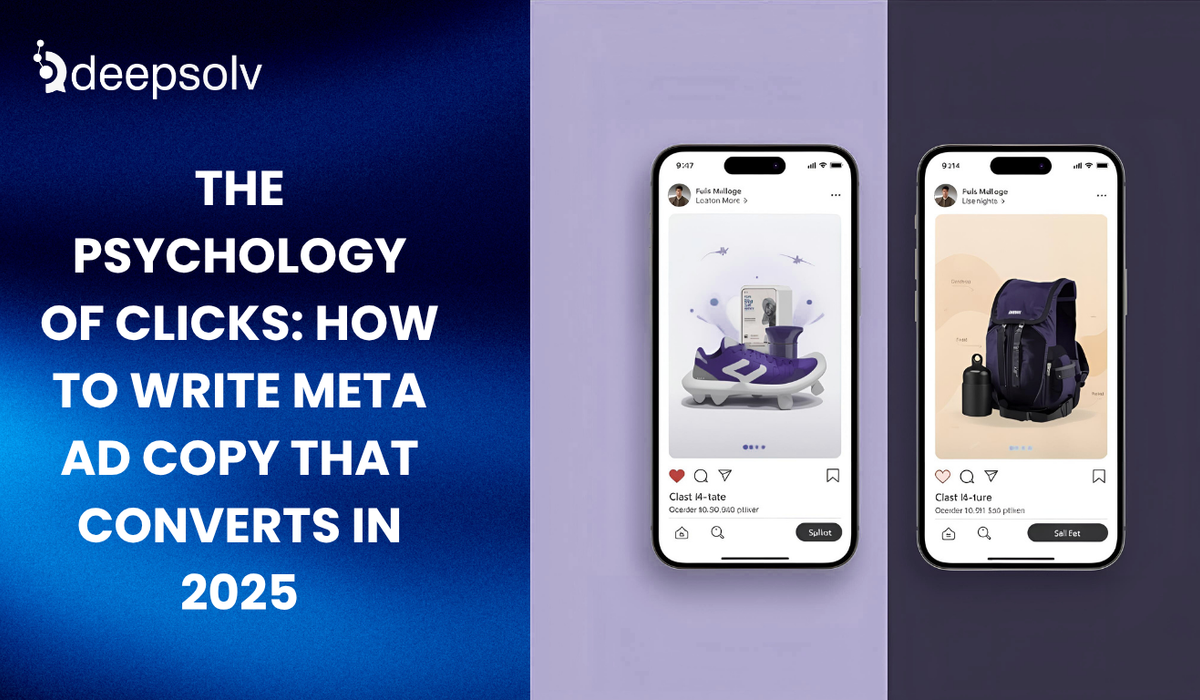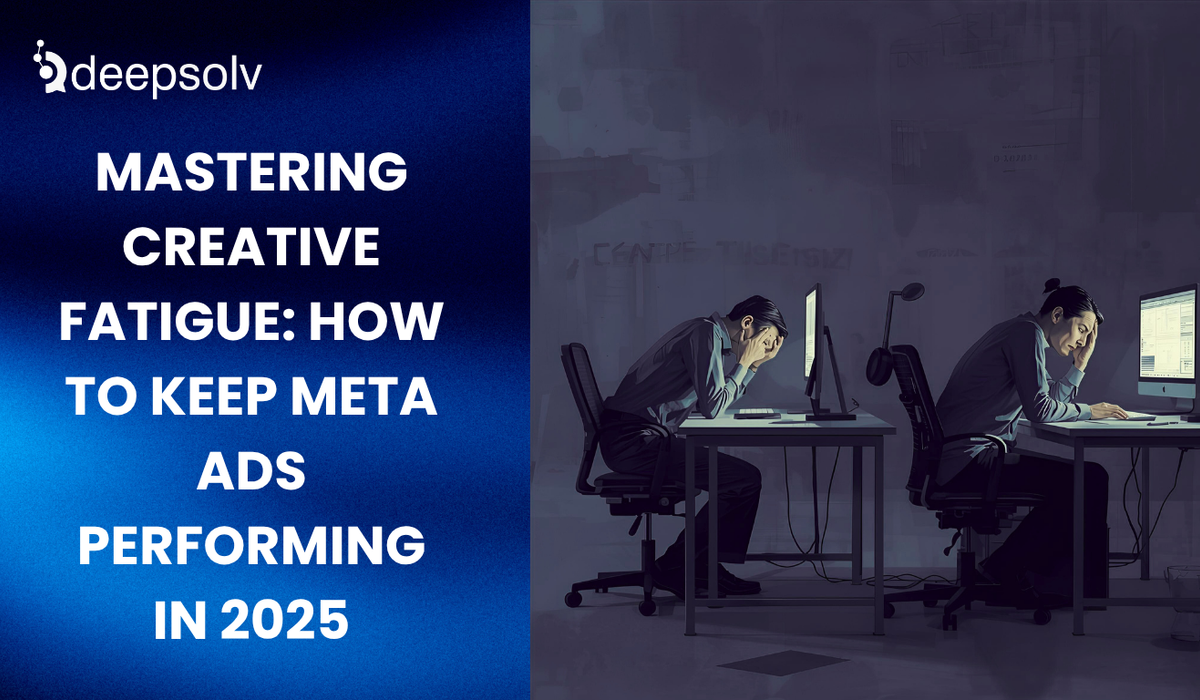The Psychology of Clicks: How to Write Meta Ad Copy That Converts in 2025
5 min read
Published: 10/3/2025

Introduction: Why Words Still Win in a World of AI Ads
It’s 2025, and Meta Ads are smarter than ever. Automation writes headlines, AI tools test creative angles, and algorithms predict intent faster than you can say “optimize.”But amidst all this machine precision, one thing remains stubbornly human — why people click.
Behind every high-performing ad lies a small psychological truth: people don’t click because of logic, they click because of emotion.
That’s why even the best targeting or bidding strategy will crumble if your ad copy fails to make someone feel something — desire, curiosity, FOMO, even relief.
This blog dives deep into the psychology of clicks- what triggers them, how consumer behavior has evolved on Meta in 2025, and how you can write copy that captures attention, builds trust, and converts faster than the competition.
The New Consumer Mindset on Meta in 2025
Meta users in 2025 are not just scrolling — they’re scanning, comparing, and subconsciously filtering noise. Their feed is cluttered with AI-generated content, short videos, and endless offers.
To stand out, your ad copy needs to:
✅ Catch attention instantly — You have roughly 2 seconds before someone swipes past.
✅ Deliver emotional clarity — Tell the viewer what they’ll feel after clicking.
✅ Signal authenticity — People don’t trust perfection; they trust personality.
✅ Guide behavior subtly — Copy that feels like a story, not a sales pitch, converts better.
Meta’s internal report from early 2025 revealed that ads written with emotionally charged language saw a 38% higher CTR than neutral ones. (Meta for Business)
In short: the 2025 Meta user doesn’t want another ad. They want a reason to care.
The Psychology Behind a Click: What Actually Makes People Respond
Let’s unpack the science — the psychological triggers that separate scroll-stoppers from forgettable ads.
1. Curiosity: The Brain’s “Open Loop” Effect
Humans are hardwired to close information gaps. That’s why cliffhangers work — and why “You’ll never believe what happened next” headlines still dominate.
Use this psychology in your Meta Ad copy by creating open loops: tease information without fully revealing it.
Example:
“This $12 skincare product went viral for one surprising reason…” “You’re scrolling past your next favorite coffee brand — unless you click this.”
Curiosity triggers dopamine — the same reward system responsible for addiction. The trick is to balance tease + payoff. Overdo it, and it feels clickbait. Underdo it, and people scroll on.
2. Relevance: Mirror Neurons and “This Feels Like Me”
When people see words or visuals that reflect their identity, their brains light up. It’s why ads that “sound like you” perform better.
Use mirroring language — copy that feels like it’s speaking from your audience’s own thoughts.
Example:
“Tired of your ads performing like it’s still 2023?” “You already love fitness — now love your routine again.”
Meta’s Advantage+ audiences work well when paired with emotionally resonant copy. The algorithm finds the right person; your copy tells them you get them.
3. Urgency and Loss Aversion
Psychologically, humans are more driven by fear of loss than potential gain — a concept known as loss aversion (Kahneman & Tversky).
That’s why “Only 3 left” or “Offer ends tonight” still outperform vague CTAs. But 2025 audiences are smarter; they can smell fake scarcity.
So how do you make urgency authentic? Tie it to context, not manipulation.
Example:
“Our limited Mother’s Day collection drops once a year. Once it’s gone, it’s gone.” “Join before Sunday and your first order ships free — after that, waitlist opens.”
4. Social Proof: The Trust Shortcut
Humans rely on social validation before acting — especially in low-trust environments like social media.
That’s why ad copy that includes proof (“Over 20,000 happy customers”) or community cues (“Join the movement”) drives conversion.
Example:
“Over 50,000 creators automate their engagement with Deepsolv — why not you?”
In 2025, authentic social proof beats polished testimonials. Use screenshots, quick UGC quotes, or short social stats over scripted praise.
5. Dopamine and “Future Pacing”
The most powerful ads don’t sell the product — they sell the feeling after using it.
That’s future pacing — helping your reader imagine themselves post-purchase.
Example:
“Imagine waking up to 100+ new leads while you sip your morning coffee.” “In 3 days, your skin glows. In 7, people start asking your secret.”
It’s visual, emotional, and instant. It activates dopamine — the chemical reward that turns interest into action.
The Perfect Meta Ad Copy Framework (2025 Edition)
Here’s the formula that top-performing brands are using to consistently out-convert others on Meta:
[Hook] → [Empathy Line] → [Benefit with Emotion] → [Proof] → [Call-to-Action]
Example 1 – For a D2C Fitness Brand
Hook: “Still waiting for motivation? It’s not coming.”
Empathy: “We get it — life’s busy. But 10 minutes a day can change everything.”
Benefit: “Join our 30-day reset and build a body that loves you back.”
Proof: “Over 12,000 members already did.”
CTA: “Start your reset today.”
Example 2 – For a SaaS Tool (Deepsolv)
Hook: “Your ads don’t need more budget — they need smarter insights.”
Empathy: “If you’re tired of guesswork and rising CPMs…”
Benefit: “Adam by Deepsolv tracks what works for your competitors — and helps you create better in minutes.”
Proof: “Used by 40+ DTC brands scaling to $1M/month.”
CTA: “Book your free strategy session today.”
This format works because it aligns with the way the human brain processes decisions: emotion → validation → logic → action.
Copywriting in 2025: What’s Actually Working Now
Here’s what the top-performing Meta Ad copy trends look like in 2025:
| Trend | Why It Works | Example |
| Short emotional hooks | Feeds are faster; long intros die quickly | “You deserve better ads. Here’s how.” |
| Conversational tone | Feels native to Meta’s UX | “We tried 100 hooks. Only 3 worked — here they are.” |
| UGC-style storytelling | Feels authentic, not corporate | “I spent $300 on bad skincare. Then I found this.” |
| Data-backed credibility | Shows authority | “9 out of 10 creators boosted engagement with this tweak.” |
| Micro-CTAs | Invite small actions | “Tap to see how it works.” |
Remember: people are scanning, not studying. Your copy needs to feel like a message from a friend, not a pitch from a brand.
How Adam by Deepsolv Elevates Your Ad Copy
2025 is the year of data-informed creativity. That’s where Adam by Deepsolv comes in.
Adam analyzes top-performing competitor ads across Meta, TikTok, and YouTube, surfacing:
- Which hooks drive the most engagement
- What tone and phrasing perform best in your niche
- What kind of emotional triggers are trending (FOMO, relief, curiosity, etc.)
Then it generates ad briefs and scripts tailored to your brand tone.
The result? Copy that’s not only psychologically sharp but also contextually optimized — you’re not guessing what works; you’re cloning success with originality.
Real-World Example: Turning Psychology Into Performance
A D2C jewelry brand was struggling with ad fatigue. Their copy focused on product features (“14k gold, handcrafted”).
Using Adam’s insights, they pivoted to emotion-first copy:
“She’s not expecting a gift — she’s expecting to feel seen.”
CTR jumped 41%, and ROAS improved by 26% within two weeks.
🧠 Because emotion beats explanation every single time.
Quick Checklist: Before You Publish Your Meta Ad Copy
✅ Does your hook create curiosity or emotion?
✅ Is your tone conversational, not corporate?
✅ Have you mirrored your audience’s language?
✅ Does your CTA create urgency or anticipation?
✅ Have you proofread for simplicity — not perfection?
If you can say yes to all five, your copy is ready to compete in 2025.
Conclusion: Your Words Create Clicks — Not Your Budget
In 2025, every advertiser has access to the same tools, targeting, and formats.The difference between an ad that gets scrolled past and one that sparks action lies in psychology — understanding what people crave, fear, and desire.
Meta Ads are no longer about who spends the most. They’re about who connects the best.
So before you launch your next campaign, remember:
- Lead with emotion.
- Mirror your audience’s thoughts.
- Sell the feeling, not the feature.
And if you want to scale faster, let Adam by Deepsolv write smarter for you.
⚡ CTA: Ready to Turn Words into Conversions?
Don’t let your next campaign underperform because of average copy. 👉 Schedule your free Meta Ad Copy Audit with Deepsolv and discover how Adam can help you craft psychologically powerful, high-converting copy in minutes.
FAQs
Frequently asked questions related to this blog post


